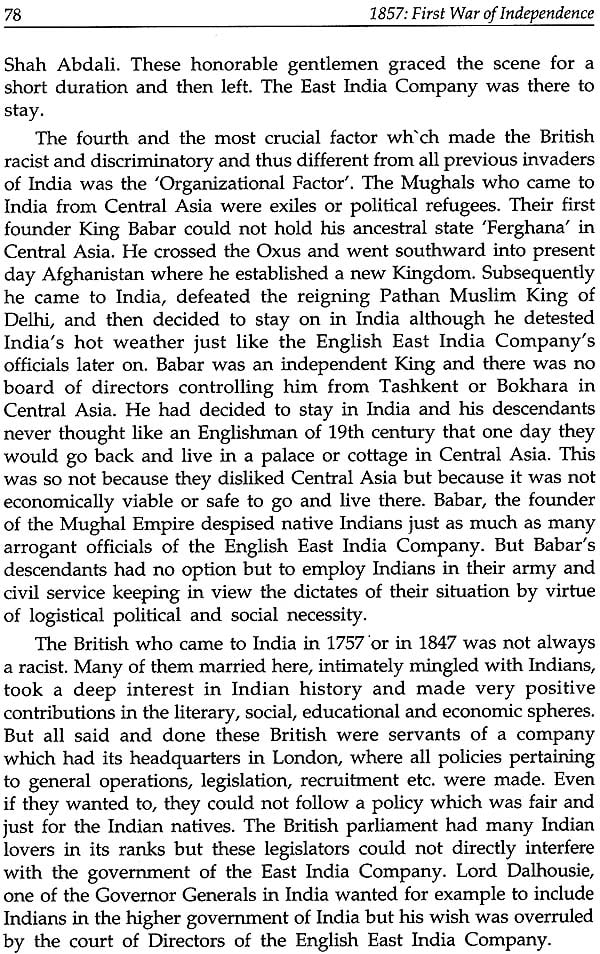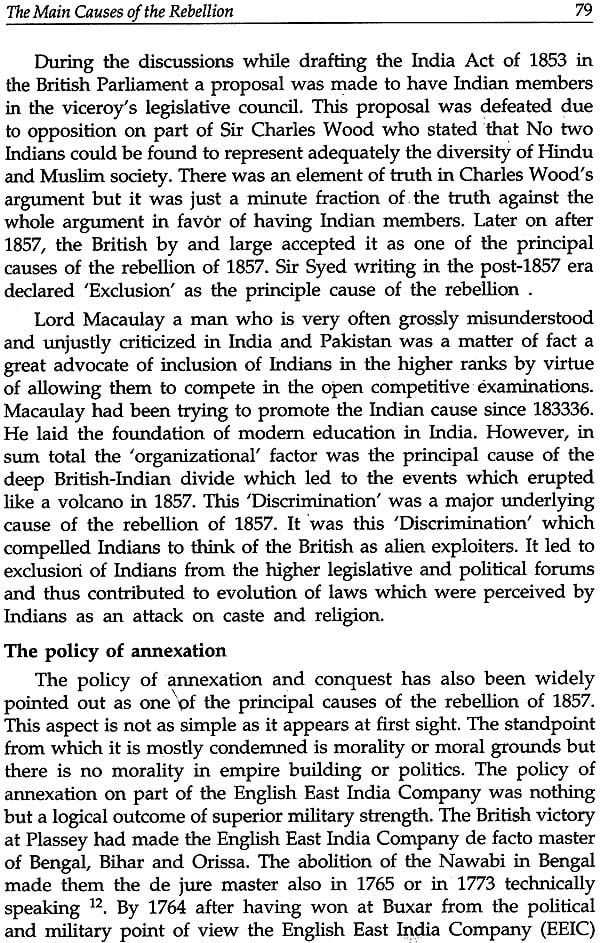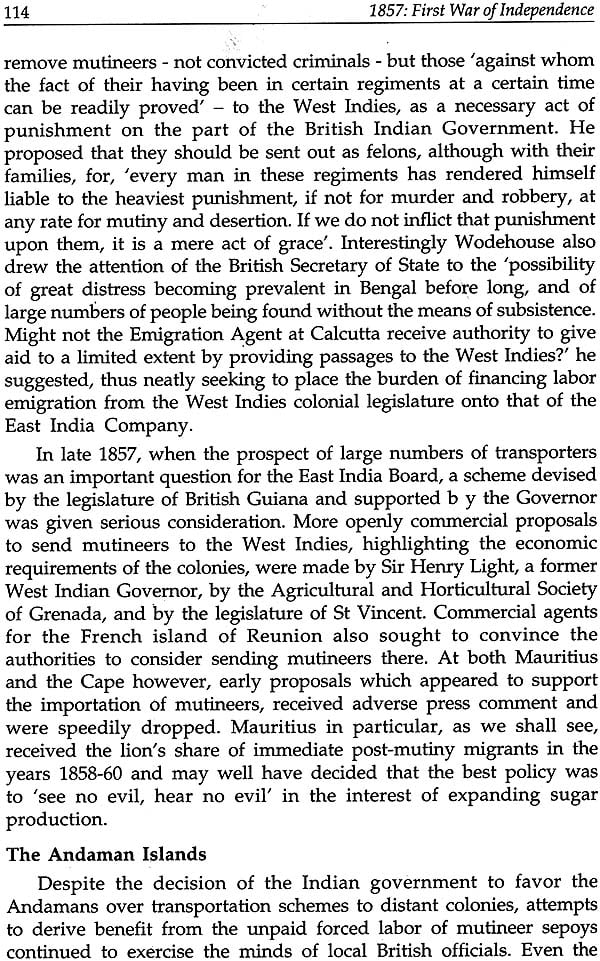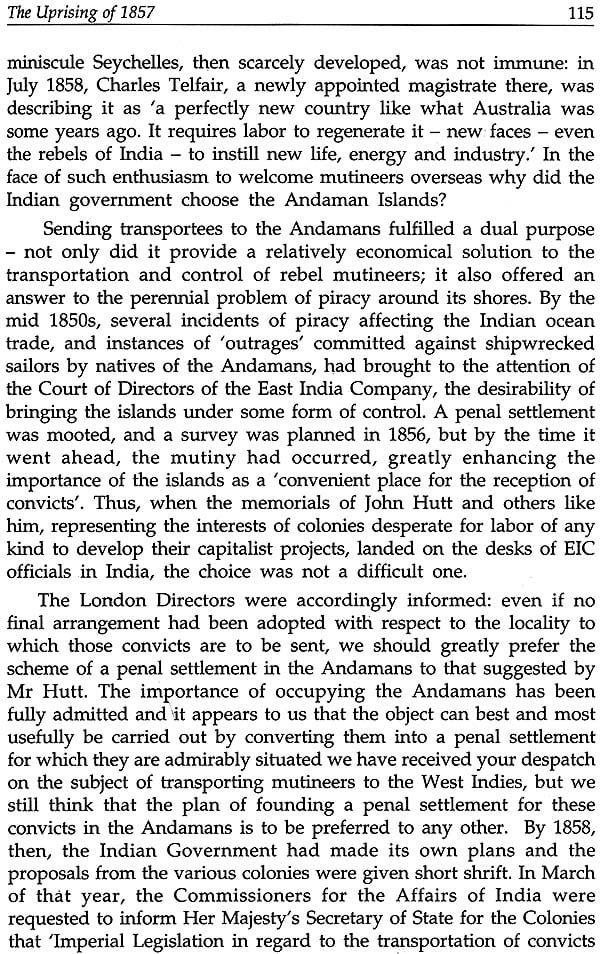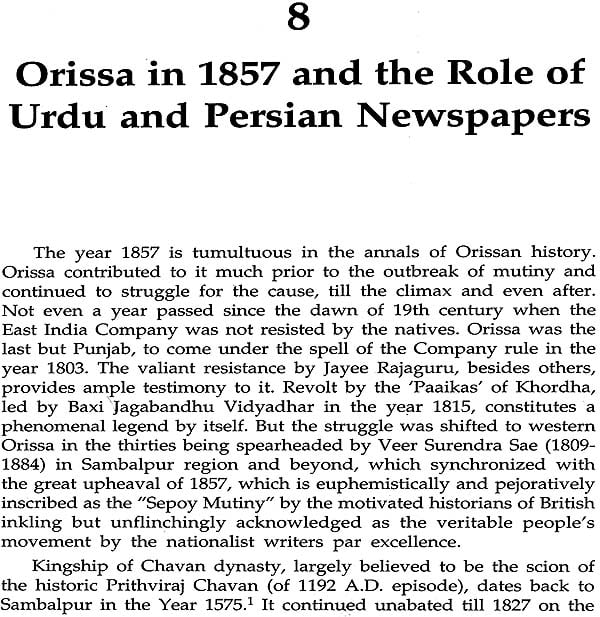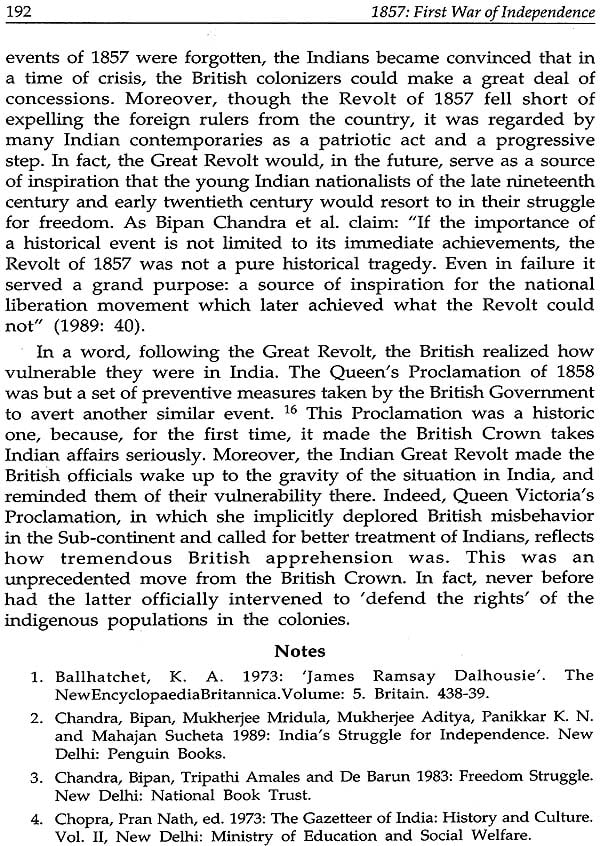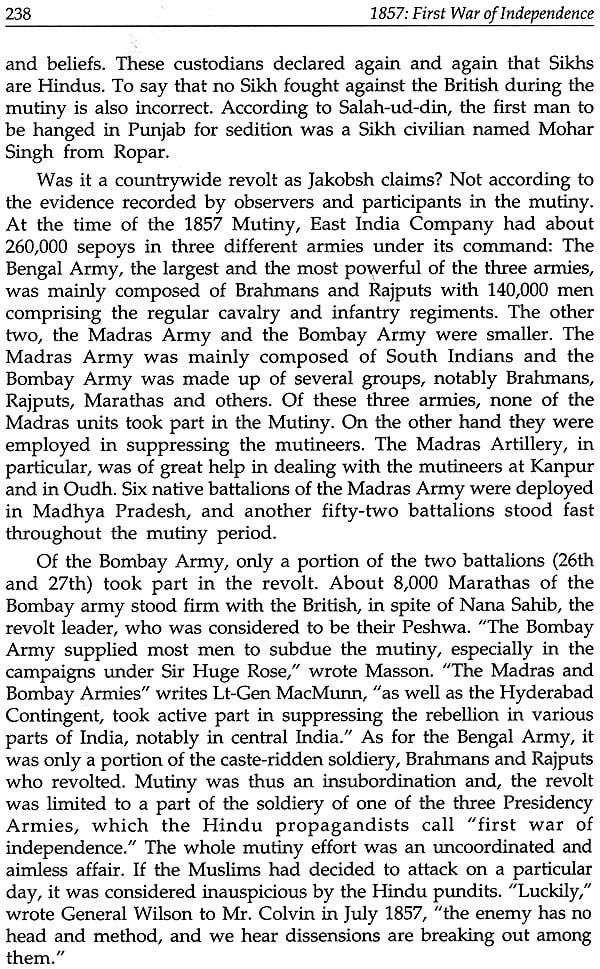
1857 First War of Independence
Book Specification
| Item Code: | NAJ131 |
| Author: | Bhujang Ramrao Bobade and Omshiva Ligade |
| Publisher: | B.R. Publishing Corporation |
| Language: | English |
| Edition: | 2017 |
| ISBN: | 9789386223098 |
| Pages: | 254 |
| Cover: | Hardcover |
| Other Details | 9.5 inch X 6.5 inch |
| Weight | 580 gm |
Book Description
Up to the nineteenth century, nothing had ever seriously threatened British rule in the Indian Sub-continent the way the happenings of 1857 did. In fact, the East India Company officials there were caught unawares and unprepared for such an unexpected ordeal. The revolution which broke out against the British rule, for some times gave a feeling that the British Empire would disappear from India. First time the people of India raised their strong voice against the mighty British. So the year 1857 is a defining period in Indian History. But the character of the great uprising of 1857 is controversial. The Scholars of England called the famous event of 1857 as the sepoy Mutiny. On the other hand some Indian historians have preferred to portray it as the “First war of Independence.” It is not justified to say that the great event was simply a sepoy mutiny. The problem of naming the events of 1857-59 is almost a commonplace in historical writings and not without reason, for the choice of a name implied an explanation of those events, and explanations were usually tied to political positions. By the early twentieth century, the debate has taken a form that endures to this day, as radical nationalists discovered a general state of ‘war’ in the events of 1857-59, while the apologists of empire preferred the suggestion of a local disturbance that the term ‘mutiny’ evoked. In this book we narrate the same history on the basis of some unpublished archival documents.
Bhujang R. Bobade (Born 1982) from last Nine years, Bobade is in the consulting world to take the helm in Archival and Museum field at a time of crisis and change. He went through a dramatic turnaround. He started bootstrapping growth. Now, he is on the doorstep of a major expansion. It's exciting and tiring and rewarding as ever building a rigorous strategic framework under his creative, community-based work. In his all last years, it was all about getting the programming moving, experimenting, and exploring the possibilities with spreading historical research in our community- History for Society Research. He is also working on different historical and educational Museums committees.
Dr. Omshiva Ligade (Born 1968) is an eminent Indian historian of medieval and Modem India, following the approach of Cultural historiography. He has a great experience of Under Graduate and Post Graduate teaching also. He is well known for his strong stance about Numismatic and research orientation work. He has authored a number of books, including Syllabus books chapters. He is head of History Dept., Shivjagruti Mahavidhyalaya, Nalegaon Dist. Latur from last 14 years. He was Chairman of State and National conferences, workshops about History and Gandhian thoughts. He is executive editor of different National and international research journals. He is said to be the first historian to use inscriptions and pictorial sources for the teaching of history which is what current days students of history do. He is said to be a pioneer in throwing light on judicial system in late medieval period.
Many of the landmark events in the history of Indo-Pakistan Subcontinent during the British rule have remained subject to grave disagreements and dissents. The Uprising of 1857 is among the biggest of these landmarks marred by a number of controversies. This paper is only an attempt at analyzing the events that transpired during the Mutiny /war. From its naming ('Sepoy Munity' or at best 'The Indian Mutiny' or simply war of Independence) to the lessons that can be learnt from it, the subject has been divided into units which are further explained in chapters.
A brief Introduction in the first unit and a historical background in the second try to paint the picture of the occurrence of events as they did happen at the time. Unit three analyzes the old debate of naming the event, causes and the main centers of the revolt. Unit four to eight analyses the actual uprising, the partakers and victims - famous or otherwise. In the last unit, an analysis of the lessons that can be drawn from the uprising and concluding remarks to sum up this book has been documented.
First War of Independence of India- 1857 (A critical Anyalsis) has been exhaustively researched and written in the plain most possible way in the hope of contributing an analytical view to the subject.
Up to the nineteenth century, nothing had ever seriously threatened British rule in the Indian Sub-continent the way the happenings of 1857 did. In fact, the East India Company officials there were caught unawares and unprepared for such an unexpected ordeal. The revolution which broke out against the British rule, for some times gave a feeling that the British Empire would disappear from India. First time the people of India raised their strong voice against the mighty British. So the year 1857 is a defining period in Indian History. But the character of the great uprising of 1857 is controversial. The scholars of England called the famous event of 1857 as the Sepoy Mutiny. On the other hand some Indian historians have preferred to portray it as the "First war of Independence." It is not justified to say that the great event was simply a sepoy mutiny.
The problem of naming the events of 1857-59 is almost a commonplace in historical writings and not without reason, for the choice of a name implied an explanation of those events, and explanations were usually tied to political positions. By the early twentieth century, the debate had taken a form that endures to this day, as radical nationalists discovered a general state of 'war' in the events of 1857-59, while the apologists of empire preferred the suggestion of a local disturbance that the term 'mutiny' evoked.
The 'mutiny or war' question has tended to isolate the events of 1857-59 from other instances of the nineteenth-century colonial 'small war', whether in China, Afghanistan, New Zealand, Jamaica or North Africa, all of which were moments of resistance against colonial domination, and shared certain tactical and strategic similarities. Theories of the 'small war', which have appeared in recent decades in several guises, may perhaps yield some new tools for reviewing the rebellion.
This book is an attempt to present a pragmatic analysis to all these questions and controversies regarding the nature and character of the Uprising of 1857 in the light of information available about its events and the different players and forces who shaped and influenced this epoch making landmark in the history of Indian Subcontinent.
1857 is an important landmark in the history of Indian subcontinent. This landmark event has been called mutiny, rebellion, war, uprising and war of independence depending on who described the event. Several different factors were at play long before the rebellion but the sudden outburst of violence and its rapid spread gave the movement a transient unity of purpose despite stark differences and diversity of India. Various individuals and different groups joined the rebellion for different reasons. The presence of so many different factors makes the task of comprehensive analysis of 1857 in any single work impossible.
The Rebellion of 1857 was by far the largest, most widespread, and dangerous threat to British rule in India in the nineteenth century. One of its most obvious repercussions was the elimination of the ruling East India Company and the transfer of control of India to the British Crown. As a military crisis of truly massive proportions, the Rebellion also inspired the structural transformation of both the British and Indian armies. In Britain, the crisis resulted in the amalgamation of the East India Company's European forces into the line, and the commitment of a permanent, 80,OOO-man garrison on the subcontinent.? In India, the mutiny or disbandment of sixty-nine out of the seventy-four regiments of the Bengal army necessitated its entire reconstruction with men as different in origin as possible from those who had so recently rebelled.
The Rebellion, however, was much more than a military crisis. In north-central India-especially around Awadh (Oudh)-mass peasant uprisings accompanied the military rebellions, thus demonstrating the existence of broad-based antipathy to British administrative and economic policies there. In addition, the Rebellion generated unprecedented interest in Britain, where ordinary citizens followed its events with fascinated horror-a phenomenon that has prompted some historians to call it Britain's 'first 'national-popular' war.
Ideologically, the Rebellion dramatically increased racial antagonisms between Britons and Indians. On the British side, this was in large part due to the fact that English-language accounts of the Rebellion framed it in terms of a savage attack on British women and children, who were allegedly being raped and murdered by fanatic soldiers in alarming numbers. Thus, public outrage over the violation of 'innocent' Britons fuelled an emotive and vengeful response to the Rebellion. On the Indian side, widespread British atrocities against both mutinous soldiers and Indian civilians left little doubt that British notions of justice and due process did not always apply to colonial subjects. Indeed, the violence of colonial rule in India was at its most exposed during the Rebellion.
Especially since Indian Independence in 1947, the Rebellion has been a highly contested area of historical inquiry, and controversies over interpretation, significance, and even about what to call the conflict remain unresolved today. Conventionally, British historians depicted the conflict as a purely military mutiny and, often, as a heroic fight against depraved sepoys intent on rape and murder. In the last fifty years, scholars in the postcolonial era have challenged such interpretations, and have emphasized previously silenced themes in the conflict, including the scale of British atrocities and the peasant aspect of the uprisings. 6 This essay engages some of these historical controversies at the same time as it seeks to provide an introductory overview to the origins, chronology, consequences, and themes of the Rebellion.
Origin
In 1857, the British East India Company controlled more than 1.6 million square miles of territory on the subcontinent, including the newly annexed states of Sind (1843) and Punjab (1849). This vast area was controlled and protected by an equally vast military force, composed of three distinct armies centered on the presidencies of Madras, Bombay, and Bengal. In 1856 its combined native troops alone numbered 280,000 men, making it the largest all-volunteer mercenary army in the world and a powerful strategic tool for British world dominance. 7 Yet just one year later its strongest military arm-the Bengal Army-looked as though it might also prove to be the downfall of British rule in India.
Although the East India Company had begun as a trading company in the seventeenth century, its transition to a territorial empire in the eighteenth century required that it place military concerns at the heart of its policy. Foremost among these concerns was to ensure the stability of Company rule through the suppression of internal unrest and the security of its borders and alliances. The very structure of Company rule reflected these concerns. Due initially to difficulties in transport and communication and later to a strategic desire to 'forestall dangerous pan-Indian combinations,' each of the three centers of Company control at Madras, Bombay, and Calcutta maintained separate military establishments, commanders-in-chief, and military staffs as well as civil governments. 8 Loosely coordinating policy between the presidencies were the Governor-General in Council and the Commander-in-Chief of the Indian Army (also CIC of the Bengal Army), both based in Bengal. Between them they controlled policy on war, diplomacy, and revenue collection for the whole of India.
The combined forces of the Indian Army were composed of a multitude of peoples and traditions. 9 Europeans served in each of the Company's three presidency armies, and British regulars served on a rotating basis as imperial garrison troops. In 1857, the total number of European forces in India was about 40,000, though Company and Crown troops were kept quite separate and regarded one another with mutual distaste.
Small and divided as the European forces in India were, they were nevertheless regarded as a vital security against domination and revolt by the far larger numbers of indigenous mercenary volunteers that made up the bulk of the troops in the Indian army.
Some of these forces stood outside the command structure of the presidencies as irregular troops. Units like the Frontier Scouts were commanded independently by British officers. Others, such as the Punjab Irregular Force, were commanded directly by Lieutenant Governors and were answerable to the Government of India in the Foreign Department rather than the Commander-in-Chief in Bengal. Still others came from the standing armies of the Princely States, nominally independent areas that received British agents at court and offered friendly military alliances in return for financial and political rewards.
Most native troops, however, served in the three presidency armies of Madras, Bombay, and Bengal, of which by 1857 the Bengal army was by far the largest. Native volunteers were recruited in large numbers partly because of the vast span of British territory that needed protecting, partly because of the large resources of manpower various Indian populations offered, and partly because native soldiers were less expensive, better disciplined, and healthier than their European counterparts. 13 Also, native troops of diverse areas were relatively easy to recruit into the Indian army. This was true for several reasons.
First, the British tended to recruit from populations, like the Rajputs of northern India, who came from long traditions of pre- colonial military service, and who perceived military service as both a respectable and honorable means of employment. This focus on areas of traditional military service meant that only seldom did the British have to resort to direct recruitment, relying instead on family and village connections to supply fresh recruits. Second, unlike the British regular army the salaries offered by the Company were respectable and steady, although by 1857 pay had not kept pace with the cost of living and was increasingly less attractive. 15 Third, military service in the Company offered added benefits-in the form of special pay or land grants-for those willing to serve in foreign stations, and for those with long service, good conduct, or conspicuous acts of bravery in battle.
| Foreword | vii | |
| Preface | ix | |
| 1 | Introduction | 1 |
| 2 | Literature Review | 23 |
| 3 | Historical Background | 33 |
| 4 | Mutiny or War of Independence | 53 |
| 5 | The Main Causes of the Rebellion | 67 |
| 6 | The Uprising of 1857 | 101 |
| 7 | The Role of the Sikhs and Muslims conspiracy during the Mutiny of 1857 | 129 |
| 8 | Orissa in 1857 and the Role of Urdu and Persian Newspapers | 159 |
| 9 | British Reaction to the Revolt | 179 |
| 10 | The Infamous Victims of the Revolt | 195 |
| 11 | 1857 Rebellion Analysis, Lessons from the Revolt and It's Conclusion | 211 |


